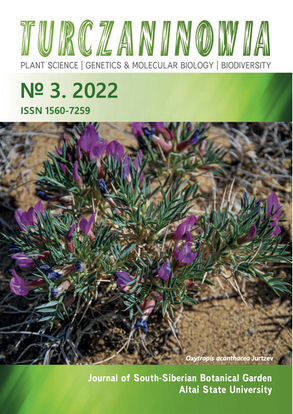Staurolemma omphalarioides (Pannariaceae, Ascomycota), a new species and genus for the lichen flora of Russia from Abrau Peninsula (North-Western Caucasus)
Abstract
The genus Staurolemma Körb., represented by the species S. omphalarioides (Anzi) P. M. Jørg. et Henssen, identified both by morphology and using DNA barcoding (ITS1-5.8S-ITS2 gene), is reported for the first time for Russia, based on materials collected in the North-Western Caucasus in the Utrish Reserve on the Abrau Peninsula. The genus Staurolemma is widely distributed in the tropics and subtropics, and only one species S. omphalarioides, has a Mediterranean-Atlantic area. As in the Mediterranean basin, in the Abrau Peninsula, the species is confined to warm and humid habitats on the Black Sea coast, where it grows in sub-Mediterranean plant communities, in oak-juniper and juniper-pistachio forests, on the trunks and branches of deciduous trees, mainly on Pistacia mutica Fisch. et C. A. Mey. and Quercus pubescens Willd. Description and photo of species are given with a discussion on their taxonomy and distribution. For some studied specimens, new rITS sequences were generated and their GenBank accession numbers are provided.
Downloads
Metrics
References
Arcadia L. 2022. The lichens and lichenicolous fungi of Greece. Online draft version 15 January 2022. ULR: https://www.lichensofgreece.com/flora.html (Accessed 05 February 2022).
Bendiksby M., Mazzoni S., Jørgensen M. H., Halvorsen R., Holien H. 2014. Combining genetic analyses of archived specimens with distribution modelling to explain the anomalous distribution of the rare lichen Staurolemma omphalarioides: long-distance dispersal or vicariance? Journal of Biogeography 41: 2020–2031. DOI: 10.1111/jbi.12347
Bilovitz P. O., Mayrhofer H. 2011. Catalogue of the lichenized and lichenicolous fungi of Bosnia and Herzegovina. Phyton (Horn, Austria) 51(1): 1–67.
Gardes M., Bruns T. D. 1993. ITS primers with enhanced specificity for basidiomycetes – application to the identification of mycorrhizae and rusts. Mol. Ecol. 2(2): 113–118. DOI: 10.1111/j.1365-294X.1993.tb00005.x
Jørgensen P. M. 2007. Collemataceae. In: T. Ahti, P. M. Jørgensen, H. Kristinsson, R. Moberg, U. Søchting, G. Thor (eds.). Nordic Lichen Flora. Vol. 3. Uppsala: Nordic Lichen Society. Pp. 14–42.
Jørgensen P. M. 2010. New discoveries in the lichen genus Staurolemma Körber. Nova Hedwigia 90(1–2): 153–159. DOI: 10.1127/0029-5035/2010/0090-0153
Jørgensen P. M., Henssen A. 1993. Physma omphalarioides – its taxonomic position and phytogeography. Graphis Scripta 5(1): 12–17.
Katoh K., Standley D. M. 2013. MAFFT Multiple Sequence Alignment Software Version 7: Improvements in Performance and Usability. Mol. Biol. Evol. 30(4): 772–780. DOI: 10.1093/molbev/mst010
Kinalioğlu K. 2009. Lichens from the Amasya, Çorum, and Tokat regions of Turkey. Mycotaxon 109: 181–184. DOI: 10.5248/109.181
Malíček J., Bouda F., Konečná E., Sipman H., Vondrák J. 2021. New country records of lichenized and non-lichenized fungi from Southeastern Europe. Herzogia 34(1): 38–54. DOI: 10.13158/heia.34.1.2021.38
Moon K. H. 1999. Lichens in Mt. Sorak. Journ. Hattori Bot. Lab. 86: 187–220.
Nimis P. L. 2022. ITALIC – The Information System on Italian Lichens. Version 7.0. University of Trieste, Dept. of Biology. ULR: https://dryades.units.it/italic (Accessed 20 January 2022).
Seaward M. R. D., Sipman H. J. M., Schultz M., Maassoumi A. A., Haji Moniri Anbaran M., Sohrabi M. 2004. A preliminary lichen checklist for Iran. Willdenowia 34(2): 543–576. DOI: 10.3372/wi.34.34218
Wedin M., Wiklund E., Jørgensen P. M., Ekman S. 2009. Slippery when wet: phylogeny and character evolution in the gelatinous cyanobacterial lichens (Peltigerales, Ascomycetes). Molecular Phylogenetics and Evolution 53: 862–871. DOI: 10.1016/j.ympev.2009.08.013
White T. J., Bruns T. D., Lee S. B., Taylor J. W. 1990. Amplification and direct sequencing of fungal ribosomal RNA genes for phylogenetics. In: M. A. Innis, D. H. Gelfand, J. J. Sninsky, T. J. White (eds.). PCR Protocols: A Guide to Methods and Applications. New York: Academic Press. Pp. 315–322.
Turczaninowia is a golden publisher, as we allow self-archiving, but most importantly we are fully transparent about your rights.
Authors may present and discuss their findings ahead of publication: at biological or scientific conferences, on preprint servers, in public databases, and in blogs, wikis, tweets, and other informal communication channels.
Turczaninowia allows authors to deposit manuscripts (currently under review or those for intended submission to Turczaninowia) in non-commercial, pre-print servers such as ArXiv.
Authors who publish with this journal agree to the following terms:
- Authors retain copyright and grant the journal right of first publication with the work simultaneously licensed under a Creative Commons Attribution License that allows others to share the work with an acknowledgement of the work's authorship and initial publication in this journal.
- Authors are able to enter into separate, additional contractual arrangements for the non-exclusive distribution of the journal's published version of the work (e.g., post it to an institutional repository or publish it in a book), with an acknowledgement of its initial publication in this journal.
- Authors are permitted and encouraged to post their work online (e.g., in institutional repositories or on their website) prior to and during the submission process, as it can lead to productive exchanges, as well as earlier and greater citation of published work (See The Effect of Open Access).





